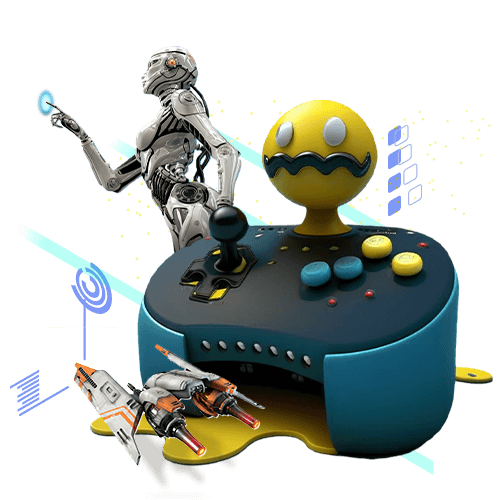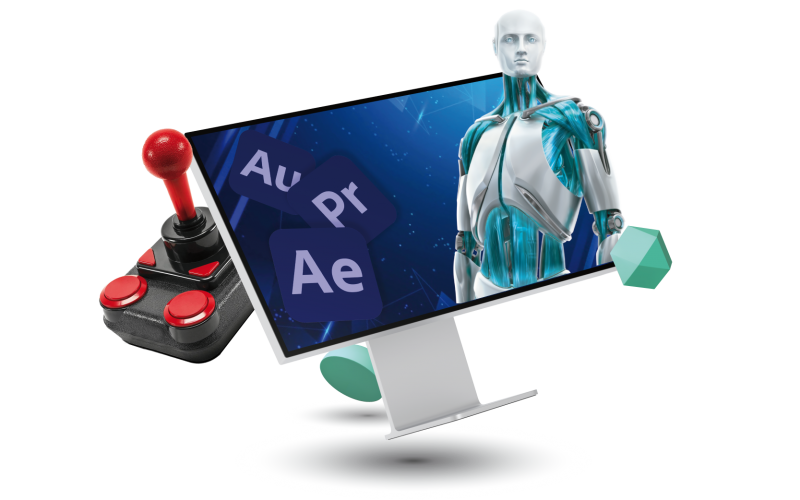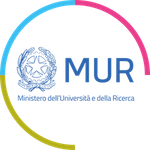Progettazione Multimediale
Graphic & Game Design
DESIGN - TECHNIQUES - APP
The future is today! Learn to design applications, to take care of their graphics and functionality. Don't stop at ideas, find out how to make them happen

DESCRIPTION
ACADEMIC DIPLOMA PROFILE

SKILLS AND ABILITIES
At the end of the First Level Academic Diploma in Media and Video Design, students will have acquired adequate technical-operational training, methods and contents relating to the fields of graphic design, software programming languages, communication and Visual Arts.
They will have acquired methodological and critical tools suitable for the acquisition of skills of expressive languages, of techniques and the most advanced technologies.
The educational path leads the student to:
- acquire specific design and technical knowledge of the expressive languages of new technologies;
- know how to use the methodologies of multimedia design;
- build design and creative awareness, as well as technical independence to independently develop the production phases of their projects;
- understand the forms and reasons for the transformation of new media languages through the study of historical disciplines and the interpretation of new trends
After the course, each student will know how to:
- Coordinate development activities of the multimedia project
- Create a storyboard of a multimedia product
- Draw up a multimedia communication project
- Design and implement a multimedia project in a team or as a freelance
At the end of the Academic Diploma, students will master the following programs:
- Office Suite
- Adobe Illustrator
- Adobe InDesign
- Adobe Photoshop
- Adobe Premiere
- Adobe Audition
- Unity
- Adobe After Effects
- Rhinoceros
- Asana
- Concept Board
- Blender
- Davinci Resolve
PROFESSIONAL FIGURES
Students of the First Level Academic Diploma in Media and Video Design will be able to work both as freelancers and at graphic studios, communication agencies, publishing houses, television channels, and web agencies as the following professional figures:
- Webmaster
- Designer and administrator of websites and multimedia products for organizations, institutions and private companies
- Administrator and manager of databases and computerized archives
In different fields such as:
- Archives
- Film libraries
- Media libraries
- Cultural associations
- Management services of repositories, databases and digital libraries active on the network
PROGRAM
PROGRAM
1st YEAR
Digital Applications For Art
The course addresses the various application aspects of the digital world in everyday life, through theoretical notions, practical analysis, the study and use of digital applications in the artistic world. Students will design projects aimed at print, video and web, from cinema to multimedia, professional photo editing, graphic design and a correct and balanced setting of the work.
Theory and Analysis of Cinema and Audiovisual
The aim is to increase the knowledge and skills inherent of audiovisual techniques in advertising and marketing. Particular reference will be given to sociological theories of mass media, to the design and development of advertising messages, and to persuasive communication, by analyzing narrative techniques and branding management in cinema.
Information for Art: Means and Methods
The course aims to prepare participants professionally to deal with the management and promotion of art and its commercial effects, by providing all the historical and “field” information with classroom simulations and guided tours. The aim is to prepare students to work in the world of art, knowing that there can be various kinds of positions within that world with specific characteristics that are also very different from each other.
History of contemporary art
The new client relationships between the bourgeoisie and art, “art for art”, the end of “academicism”, autonomous choices and independence in the artist’s experimental and personal research. The relationship between the various movements and those of the first half of the century.
Design Methodology of Visual Communication
The aim is to introduce the student to the design methodology which is the basis of the main communication models of history. Being able to implement the right strategies to design and create a collective multimedia product, which could be a short film, a newspaper, a blog, an art book, an advertisement, an app.
Multimedia Design
The course aims to analyze, on a theoretical and practical level, the methodologies for applying information and media technologies to artistic and aesthetic production, from installation to performative areas, highlighting the transversality of languages and communication codes made possible by the use of digital.
Aesthetics Of New Media
The lessons will trace the development lines of means of communication, with particular attention to the most recent developments in the media. First of all, the course will emphasize the logical progression of the tools and of the classic forms of communication. In fact, we will see the evolutionary traces of the theories and current aesthetic and artistic discourses, without neglecting the historical-social component.
Latest Trends In Visual Arts
Through the passages of modernity, the historical avant-gardes, the transformations of the work of art between the fifteenth and seventeenth centuries, up to the postmodern era and the current globalized world, the history of artistic trends and practices is continually placed in relationship with geography, culture and history.
Anthropology of Art
The course will present and compare different routes of artistic exploration of field research and anthropologically relevant themes such as otherness, belonging, the body, exile and the relationship, tradition-modernity. It will examine the expectations of authenticity and exoticism that underpin the criteria for the visibility of non-Western art in the international art system
Fundamentals of Computer Science
The goal of the course is to respond adequately to the challenge launched by the job market, not only through knowledge and deepening of cultural and technical areas, but also through the “tools” through which the work process is completed. The mastery of an adequate tool is an indispensable condition for the achievement of a valid and productive goal for our work requirements.
English
The objective of this course is to help students increase their language comprehension and production skills to bring them to an intermediate level – B1 according to the Common European Framework of Reference for Languages (CEFR) – through a gradual path that will be adapted to each student’s necessity.
PROGRAM
2nd YEAR
Theory of perception and psychology of form
The course proposes the study of the various theories concerning the functioning of the brain in relation to sensoriality and the study of the relative models and the consequent applications. It also illustrates the concepts of the theory of form adapted into the various subjects studied in the academy of fine arts, through examples of works of art.
Digital photography
The course highlights the importance of photographic language as a tool of communication, expression and research both on a theoretical and a practical level. It provides the necessary teachings in order to develop and understand the importance of composition, to know the techniques of indoor and outdoor shooting, the treatment of sensitive material both in analogue and digital, the technology of the camera, the choice of equipment, the exposure and measurement of light, the language of optics, landscape photography and professional studio photography, developing a specific knowledge of photographic language.
Multimedia Languages
The course aims to analyze the multimedia languages used in the most different applications in the digital field. Through the study we arrive at the design of new languages that are capable of communicating as a new universal language.
Sound Design
The course aims to train students in the creation of a sound environment starting from a fundamental principle: designing sound is, first of all, a creative act that requires even a minimum basic knowledge of the fundamental constructive principles of sound and of music. The student will acquire the basic technical and theoretical skills to design sound with awareness and attention to the final aesthetic result, which is necessary in both the artistic and commercial fields.
Audiovisual Techniques for the Web
The aim of the course is to open the possibility of seeing, imagining and designing an audiovisual product for the website to the student. Leaving the limits imposed by normal commercial programs, students will analyze the trends of web communication and will find new and creative systems for a constantly evoluting market.
Digital Video
The course is a workshop where you can experiment with digital technology in the field of video. Practice and theory have a parallel trend in order to activate multiple views on the various genres in which video technology is applied. Particular relevance includes the individual exercises of shooting, writing, editing and the analysis of audiovisual material belonging to different genres. These exercises have research and experimentation of language and of the medium as their purpose.
Net Art
Introduce the student to the theoretical principles of Net Art and the interdisciplinary intersections connected, the objectives of the main practices, the subjects carried out, in order to define a new possible horizon for the work of art. The student will deepen the sector of Augmented Reality through a specific exercise. The course aims to help students to look at communication, at the field of the relationship with others, and at improving the community universe as one of the main development paths of the art of new communication technologies.
Digital Modeling Techniques
Knowledge and in-depth study of commands and techniques for the visualization and spatial verification of each design idea and the production of basic three-dimensional drawings directly from the model. The possibility of applying the modeling technique ranges from mechanics, to design, to architectural drawing.
Use Of Web Software
Study and use of major software utilized in programming and graphic creation of web applications. Study of the relative programming languages, of the operating logics and of the potentials and limits of each of them.
PROGRAMMAaPROGRAM
3rd YEAR
Procedures and techniques for multimedia entertainment
The course aims to deepen the specific knowledge of themes and technical methodologies inherent to the realization of projects for the multimedia show and for interactive installations, as well as knowledge of analysis of the different installation and scenographic typologies in relation with organized spaces and meeting places that could be physical or not (web).
Practice and Culture of Entertainment
The course aims to examine the relationship between scene and music, intending, first of all, to provide students of Scenography with the basic elements of knowledge of musical theater, in its historical-theoretical and social aspects. The course will also address the most relevant elements of the recent development of entertainment of the forms of shows and of visual communication.
Screenplay for Videogames
The Videogame as a language of communication. Introduction to the basic elements of Scriptwriting. Research for sources of inspiration. Invention and elaboration of ideas. Structure of the Story: from the Idea to the Subject, to the development of the characters.
Integrated New Media Techniques
Introduction to the complexity of integrating languages of different technical and semantic nature in multimedia works.
Video Music
Study of contemporary trends in video music by analyzing success stories and the latest trends. Conception and realization of an audio-video product through the knowledge acquired during the previous years.
Internship
Students will be able to carry out an internship at a company or a professional studio in order to follow the development of a project from its conception to its realization, collaborating with professionals in the sector and practicing what they have studied.
Thesis project
Each student will have to carry out a personal research work, through a written paper or a project, that will be discussed at the time of graduation..
First Level Academic Diploma authorized by MUR (Ministry of Education, University and Research)
with Ministerial Decree prot. No. 626 of 18 July 2013.
FILL OUT THE FORM
to receive more information.
We will contact you within a few hours.

